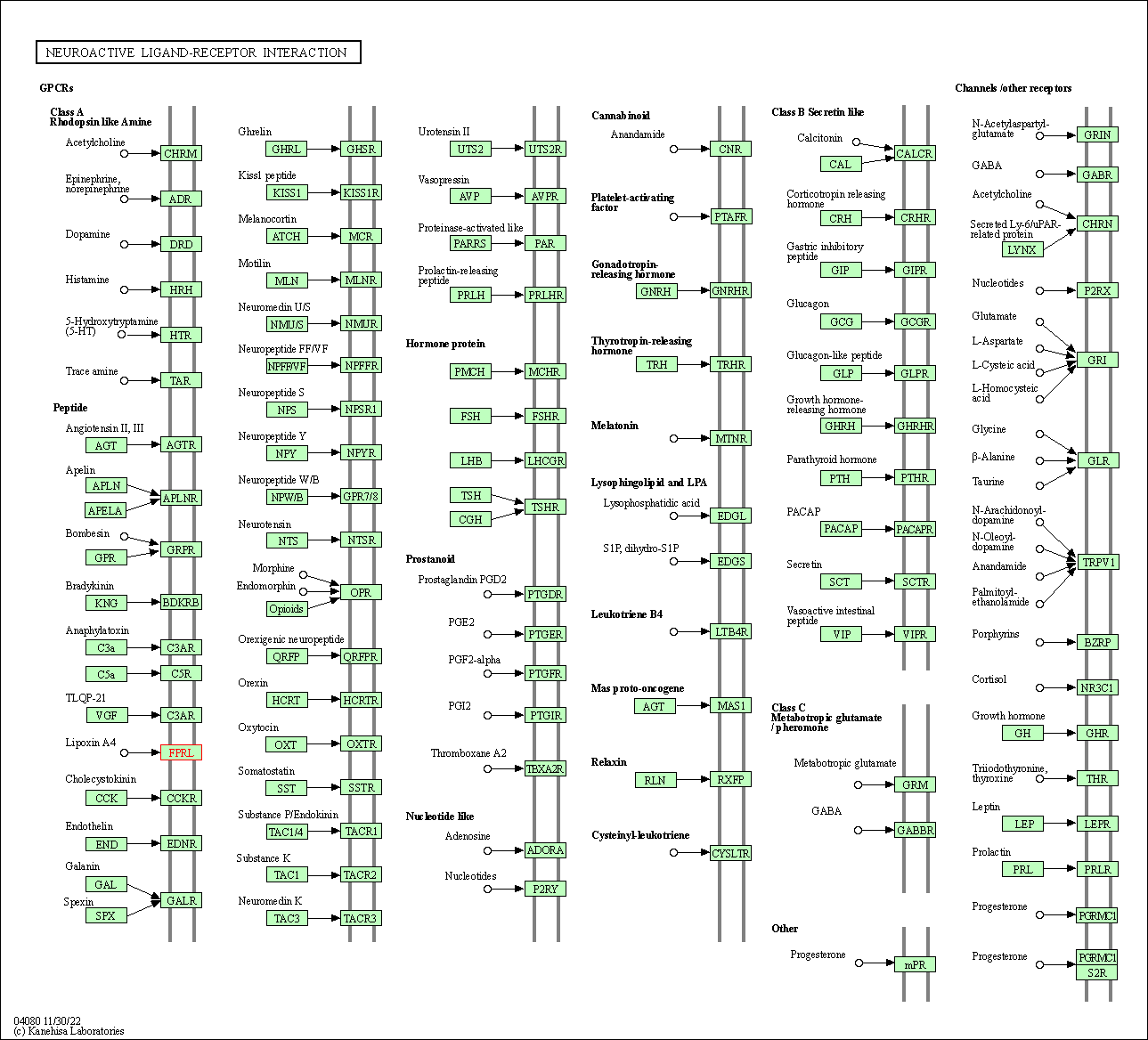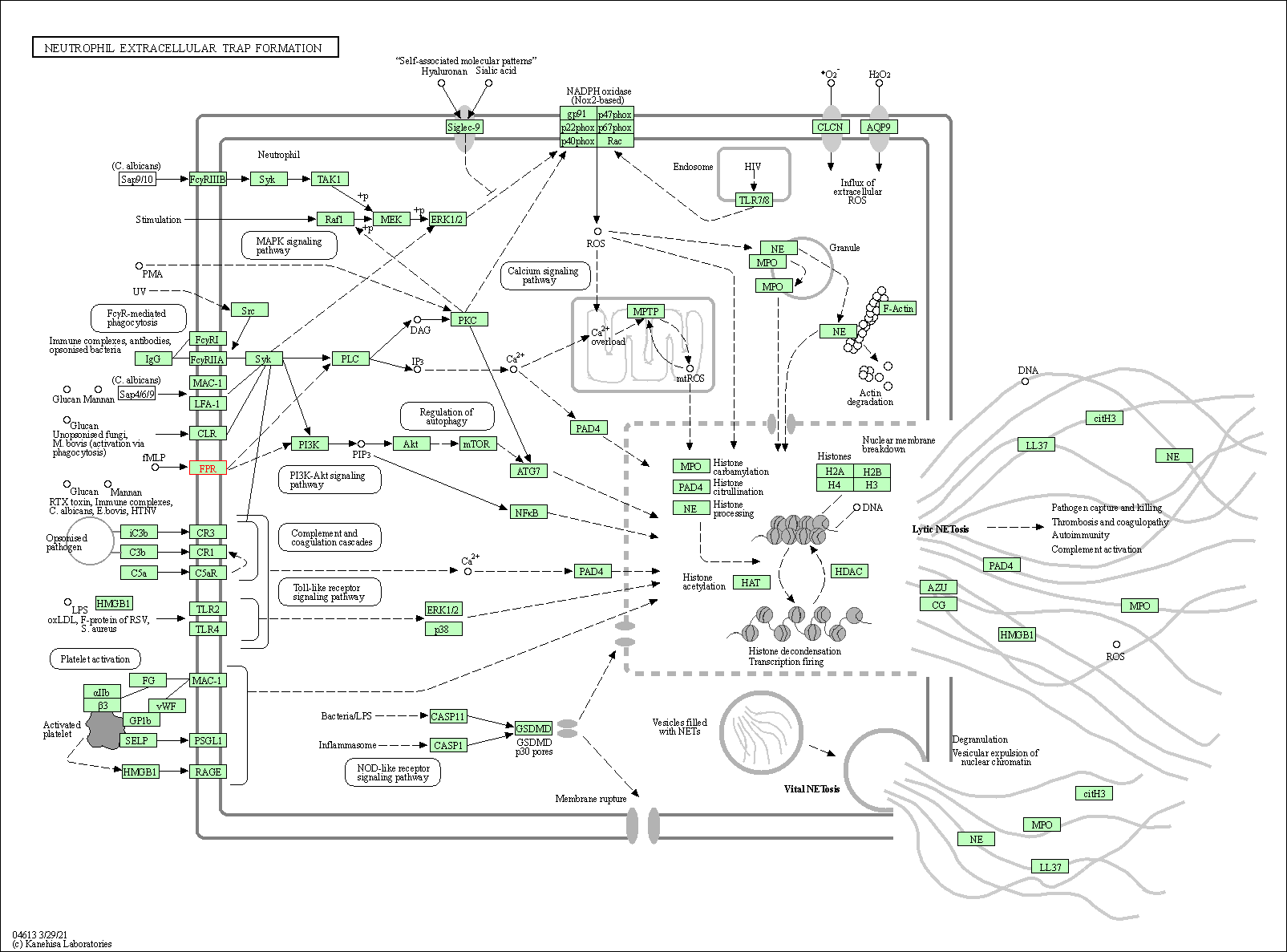Target Information
| Target General Information | Top | |||||
|---|---|---|---|---|---|---|
| Target ID |
T97917
(Former ID: TTDR00540)
|
|||||
| Target Name |
FMLP-related receptor I (FPR2)
|
|||||
| Synonyms |
RFP; Lipoxin A4 receptor; LXA4 receptor; HM63; G-protein-coupled receptor FPR-Like-1; Formyl peptide receptor-like 1; FPRL1; FPR2; FMLP-R-I
Click to Show/Hide
|
|||||
| Gene Name |
FPR2
|
|||||
| Target Type |
Literature-reported target
|
[1] | ||||
| Disease | [+] 1 Target-related Diseases | + | ||||
| 1 | Alzheimer disease [ICD-11: 8A20] | |||||
| Function |
Low affinity receptor for N-formyl-methionyl peptides, which are powerful neutrophils chemotactic factors. Binding of FMLP to the receptor causes activation of neutrophils. This response is mediated via a G-protein that activates a phosphatidylinositol-calcium second messenger system. The activation of LXA4R could result in an anti-inflammatory outcome counteracting the actions of proinflammatory signals such as LTB4 (leukotrieneB4).
Click to Show/Hide
|
|||||
| BioChemical Class |
GPCR rhodopsin
|
|||||
| UniProt ID | ||||||
| Sequence |
METNFSTPLNEYEEVSYESAGYTVLRILPLVVLGVTFVLGVLGNGLVIWVAGFRMTRTVT
TICYLNLALADFSFTATLPFLIVSMAMGEKWPFGWFLCKLIHIVVDINLFGSVFLIGFIA LDRCICVLHPVWAQNHRTVSLAMKVIVGPWILALVLTLPVFLFLTTVTIPNGDTYCTFNF ASWGGTPEERLKVAITMLTARGIIRFVIGFSLPMSIVAICYGLIAAKIHKKGMIKSSRPL RVLTAVVASFFICWFPFQLVALLGTVWLKEMLFYGKYKIIDILVNPTSSLAFFNSCLNPM LYVFVGQDFRERLIHSLPTSLERALSEDSAPTNDTAANSASPPAETELQAM Click to Show/Hide
|
|||||
| 3D Structure | Click to Show 3D Structure of This Target | PDB | ||||
| Drugs and Modes of Action | Top | |||||
|---|---|---|---|---|---|---|
| Preclinical Drug(s) | [+] 1 Preclinical Drugs | + | ||||
| 1 | humanin | Drug Info | Preclinical | Alzheimer disease | [2] | |
| Mode of Action | [+] 2 Modes of Action | + | ||||
| Agonist | [+] 12 Agonist drugs | + | ||||
| 1 | humanin | Drug Info | [3] | |||
| 2 | AG-26 | Drug Info | [4] | |||
| 3 | aspirin triggered lipoxin A4 | Drug Info | [5] | |||
| 4 | aspirin-triggered resolvin D1 | Drug Info | [1] | |||
| 5 | ATLa2 | Drug Info | [6] | |||
| 6 | fMet-Leu-Phe | Drug Info | [7] | |||
| 7 | LXA4 | Drug Info | [8], [9] | |||
| 8 | PMID22607879CR-(-)-5f | Drug Info | [10] | |||
| 9 | pyrazolone, 1 | Drug Info | [12] | |||
| 10 | quin-C1 | Drug Info | [13] | |||
| 11 | RvD1-ME | Drug Info | [1] | |||
| 12 | [3H]resolvin D1 | Drug Info | [8] | |||
| Antagonist | [+] 2 Antagonist drugs | + | ||||
| 1 | PMID23788657C1754-31 | Drug Info | [11] | |||
| 2 | quin-C7 | Drug Info | [14] | |||
| Cell-based Target Expression Variations | Top | |||||
|---|---|---|---|---|---|---|
| Cell-based Target Expression Variations | ||||||
| Drug Binding Sites of Target | Top | |||||
|---|---|---|---|---|---|---|
| Ligand Name: Cholesterol | Ligand Info | |||||
| Structure Description | Cryo-EM structure of formyl peptide receptor 2/lipoxin A4 receptor in complex with Gi | PDB:6OMM | ||||
| Method | Electron microscopy | Resolution | 3.17 Å | Mutation | Yes | [15] |
| PDB Sequence |
GYTVLRILPL
30 VVLGVTFVLG40 VLGNGLVIWV50 AGFRMTRTVT60 TICYLNLALA70 DFSFTATLPF 80 LIVSMAMGEK90 WPFGWFLCKL100 IHIVVDINLF110 GSVFLIGFIA120 LDRCICVLHP 130 VWAQNHRTVS140 LAMKVIVGPW150 ILALVLTLPV160 FLFLTTVTIP170 NGDTYCTFNF 180 ASWGGTPEER190 LKVAITMLTA200 RGIIRFVIGF210 SLPMSIVAIC220 YGLIAAKIHK 230 KGMIKSSRPL240 RVLTAVVASF250 FICWFPFQLV260 ALLGTVWLKE270 MLFYGKYKII 280 DILVNPTSSL290 AFFNSCLNPM300 LYVFVGQDFR310 ERLIHSL
|
|||||
|
|
ILE27
3.731
LEU30
3.740
VAL31
3.971
GLY34
3.633
VAL35
3.638
PHE37
3.780
VAL38
3.756
ILE82
4.210
VAL83
3.830
ALA86
4.023
MET87
4.159
PHE118
3.613
LEU121
3.994
ILE125
3.759
HIS129
3.771
TRP132
3.552
|
|||||
| Ligand Name: Pyrazolone, 1 | Ligand Info | |||||
| Structure Description | Structure of the human FPR2-Gi complex with compound C43 | PDB:7T6S | ||||
| Method | Electron microscopy | Resolution | 3.00 Å | Mutation | No | [16] |
| PDB Sequence |
AGYTVLRILP
29 LVVLGVTFVL39 GVLGNGLVIW49 VAGFRMTRTV59 TTICYLNLAL69 ADFSFTATLP 79 FLIVSMAMGE89 KWPFGWFLCK99 LIHIVVDINL109 FGSVFLIGFI119 ALDRCICVLH 129 PVWAQNHRTV139 SLAMKVIVGP149 WILALVLTLP159 VFLFLTTVTI169 PNGDTYCTFN 179 FASWGGTPEE189 RLKVAITMLT199 ARGIIRFVIG209 FSLPMSIVAI219 CYGLIAAKIH 229 KKGMIKSSRP239 LRVLTAVVAS249 FFICWFPFQL259 VALLGTVWLK269 EMLFYGKYKI 279 IDILVNPTSS289 LAFFNSCLNP299 MLYVFVGQDF309 RERLIHSL
|
|||||
|
|
||||||
| Click to View More Binding Site Information of This Target with Different Ligands | ||||||
| Different Human System Profiles of Target | Top |
|---|---|
|
Human Similarity Proteins
of target is determined by comparing the sequence similarity of all human proteins with the target based on BLAST. The similarity proteins for a target are defined as the proteins with E-value < 0.005 and outside the protein families of the target.
A target that has fewer human similarity proteins outside its family is commonly regarded to possess a greater capacity to avoid undesired interactions and thus increase the possibility of finding successful drugs
(Brief Bioinform, 21: 649-662, 2020).
Human Pathway Affiliation
of target is determined by the life-essential pathways provided on KEGG database. The target-affiliated pathways were defined based on the following two criteria (a) the pathways of the studied target should be life-essential for both healthy individuals and patients, and (b) the studied target should occupy an upstream position in the pathways and therefore had the ability to regulate biological function.
Targets involved in a fewer pathways have greater likelihood to be successfully developed, while those associated with more human pathways increase the chance of undesirable interferences with other human processes
(Pharmacol Rev, 58: 259-279, 2006).
Biological Network Descriptors
of target is determined based on a human protein-protein interactions (PPI) network consisting of 9,309 proteins and 52,713 PPIs, which were with a high confidence score of ≥ 0.95 collected from STRING database.
The network properties of targets based on protein-protein interactions (PPIs) have been widely adopted for the assessment of target’s druggability. Proteins with high node degree tend to have a high impact on network function through multiple interactions, while proteins with high betweenness centrality are regarded to be central for communication in interaction networks and regulate the flow of signaling information
(Front Pharmacol, 9, 1245, 2018;
Curr Opin Struct Biol. 44:134-142, 2017).
Human Similarity Proteins
Human Pathway Affiliation
Biological Network Descriptors
|
|
| KEGG Pathway | Pathway ID | Affiliated Target | Pathway Map |
|---|---|---|---|
| Neuroactive ligand-receptor interaction | hsa04080 | Affiliated Target |

|
| Class: Environmental Information Processing => Signaling molecules and interaction | Pathway Hierarchy | ||
| Neutrophil extracellular trap formation | hsa04613 | Affiliated Target |

|
| Class: Organismal Systems => Immune system | Pathway Hierarchy | ||
| Degree | 4 | Degree centrality | 4.30E-04 | Betweenness centrality | 1.02E-04 |
|---|---|---|---|---|---|
| Closeness centrality | 1.94E-01 | Radiality | 1.33E+01 | Clustering coefficient | 3.33E-01 |
| Neighborhood connectivity | 8.00E+00 | Topological coefficient | 2.87E-01 | Eccentricity | 13 |
| Download | Click to Download the Full PPI Network of This Target | ||||
| Chemical Structure based Activity Landscape of Target | Top |
|---|---|
| Drug Property Profile of Target | Top | |
|---|---|---|
| (1) Molecular Weight (mw) based Drug Clustering | (2) Octanol/Water Partition Coefficient (xlogp) based Drug Clustering | |
|
|
||
| (3) Hydrogen Bond Donor Count (hbonddonor) based Drug Clustering | (4) Hydrogen Bond Acceptor Count (hbondacc) based Drug Clustering | |
|
|
||
| (5) Rotatable Bond Count (rotbonds) based Drug Clustering | (6) Topological Polar Surface Area (polararea) based Drug Clustering | |
|
|
||
| "RO5" indicates the cutoff set by lipinski's rule of five; "D123AB" colored in GREEN denotes the no violation of any cutoff in lipinski's rule of five; "D123AB" colored in PURPLE refers to the violation of only one cutoff in lipinski's rule of five; "D123AB" colored in BLACK represents the violation of more than one cutoffs in lipinski's rule of five | ||
| Target Poor or Non Binders | Top | |||||
|---|---|---|---|---|---|---|
| Target Poor or Non Binders | ||||||
| Target Affiliated Biological Pathways | Top | |||||
|---|---|---|---|---|---|---|
| PID Pathway | [+] 1 PID Pathways | + | ||||
| 1 | Urokinase-type plasminogen activator (uPA) and uPAR-mediated signaling | |||||
| Reactome | [+] 2 Reactome Pathways | + | ||||
| 1 | G alpha (q) signalling events | |||||
| 2 | G alpha (i) signalling events | |||||
| WikiPathways | [+] 5 WikiPathways | + | ||||
| 1 | GPCRs, Class A Rhodopsin-like | |||||
| 2 | Gastrin-CREB signalling pathway via PKC and MAPK | |||||
| 3 | Peptide GPCRs | |||||
| 4 | GPCR ligand binding | |||||
| 5 | GPCR downstream signaling | |||||
| References | Top | |||||
|---|---|---|---|---|---|---|
| REF 1 | Resolvin D1 receptor stereoselectivity and regulation of inflammation and proresolving microRNAs. Am J Pathol. 2012 May;180(5):2018-27. | |||||
| REF 2 | ClinicalTrials.gov (NCT03431844) Humanin Isoforms in Cardiac Muscle and Blood Plasma and Major Complications After Cardiac Operation. U.S. National Institutes of Health. | |||||
| REF 3 | N-Formylated humanin activates both formyl peptide receptor-like 1 and 2. Biochem Biophys Res Commun. 2004 Nov 5;324(1):255-61. | |||||
| REF 4 | Identification of novel small-molecule agonists for human formyl peptide receptors and pharmacophore models of their recognition. Mol Pharmacol. 2010 Feb;77(2):159-70. | |||||
| REF 5 | URL: http://www.guidetopharmacology.org Nucleic Acids Res. 2015 Oct 12. pii: gkv1037. The IUPHAR/BPS Guide to PHARMACOLOGY in 2016: towards curated quantitative interactions between 1300 protein targets and 6000 ligands. (Target id: 223). | |||||
| REF 6 | Novel 3-oxa lipoxin A4 analogues with enhanced chemical and metabolic stability have anti-inflammatory activity in vivo. J Med Chem. 2004 Apr 8;47(8):2157-65. | |||||
| REF 7 | Multiple domains of the N-formyl peptide receptor are required for high-affinity ligand binding. Construction and analysis of chimeric N-formyl peptide receptors. J Biol Chem. 1993 Aug 25;268(24):18167-75. | |||||
| REF 8 | Resolvin D1 binds human phagocytes with evidence for proresolving receptors. Proc Natl Acad Sci U S A. 2010 Jan 26;107(4):1660-5. | |||||
| REF 9 | Lipoxin recognition sites. Specific binding of labeled lipoxin A4 with human neutrophils. J Biol Chem. 1992 Aug 15;267(23):16168-76. | |||||
| REF 10 | Synthesis, enantioresolution, and activity profile of chiral 6-methyl-2,4-disubstituted pyridazin-3(2H)-ones as potent N-formyl peptide receptor agonists. Bioorg Med Chem. 2012 Jun 15;20(12):3781-92. | |||||
| REF 11 | Selective agonists and antagonists of formylpeptide receptors: duplex flow cytometry and mixture-based positional scanning libraries. Mol Pharmacol. 2013 Sep;84(3):314-24. | |||||
| REF 12 | Potent hFPRL1 (ALXR) agonists as potential anti-inflammatory agents. Bioorg Med Chem Lett. 2006 Jul 15;16(14):3713-8. | |||||
| REF 13 | A novel nonpeptide ligand for formyl peptide receptor-like 1. Mol Pharmacol. 2004 Nov;66(5):1213-22. | |||||
| REF 14 | Pharmacological characterization of a novel nonpeptide antagonist for formyl peptide receptor-like 1. Mol Pharmacol. 2007 Oct;72(4):976-83. | |||||
| REF 15 | Structure of formylpeptide receptor 2-G(i) complex reveals insights into ligand recognition and signaling. Nat Commun. 2020 Feb 14;11(1):885. | |||||
| REF 16 | Molecular recognition of formylpeptides and diverse agonists by the formylpeptide receptors FPR1 and FPR2. Nat Commun. 2022 Feb 25;13(1):1054. | |||||
If You Find Any Error in Data or Bug in Web Service, Please Kindly Report It to Dr. Zhou and Dr. Zhang.

